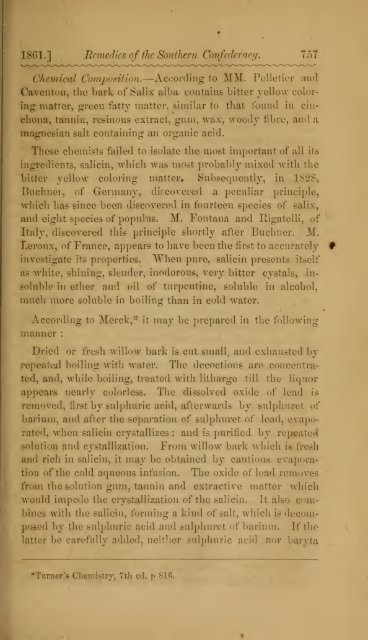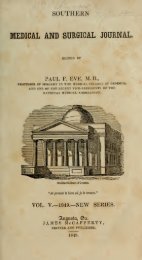istryj<strong>1861</strong>.] Remedies of the Southern Confederacy. 757Chemical Composition.—According to MM. Pelletier andCaventou, the bark of Salix albacontains bitter yellow coloringmatter, green fatty matter, similar to that found in cinchona,tannin, resinous extract, gum, wax, woody fibre,magnesian salt containing an organic acid.and aThese chemists failed to isolate the most important of all itsingredients, salicin,which was most probably mixed with thebitter yellow coloring matter. Subsequently, in 1828,Buchnei, of Germany, discovered a peculiar principle,which has since been discovered in fourteen species of salix,and eight species of populus. M. Fontana and Ttigatelli, ofItaly, discovered this principle shortly after Buchner. M.Leroux, of France, a<strong>pp</strong>ears to have been the first to accuratelyinvestigate its properties. When pure, salicin presents itselfas white, shining, slender, inodorous, very bitter cystals, insolublein ether and oil of turpentine, soluble in alcohol,much more soluble in boiling than in cold water.According to Merck,- it may be prepared in the followingmanner :Dried or fresh willow bark is cut small, and exhausted byrepeated boiling with water. The decoctions are concentrated,and, while boiling, treated with litharge till the liquora<strong>pp</strong>ears nearly colorless. The dissolved oxide of lead isremoved, first by sulphuric acid, afterward- by Biilphuret ofbarium, and after the separation of sulphuret oflead, evaporated,when salicin crystallizes ; and is purified by repeatedsolution and cystallization. From willow bark which is freshand rich in salicin, it may be obtained by cautious evaporationof the cold aqueous infusion. The oxide of lead remfrom the solution gum, tannin and extractive matter whichwould impede the crystallization of the salicin. It also combineswith the salicin, forming a kind of salt, which is decoindby the sulphuric acid and sulphuret of barium. I:latter be carefully added, neither sulphuric acid nor baryta'Turn-I7th ed. p
;7 58 Joseph J ones, on the Indigenous [<strong>October</strong>,remain in the solution ; and the sulphuret of lead which separates,acts as a decolorizing agent.I'wal Properties and Uses.—The ancients arc said tohave employed the Lark of the willow in the treatment ofdisease ; it fell into disuse, however, until 1703, when it wasbrought into hottce by Rev. Mr. Stone, who published in thePhilosophical Transactions of the Royal Society of London,an article entitled "On the Success of the Bark of the Willowin the cure of Agues by the Rev. Edm. Stone, of Cli<strong>pp</strong>ing-Norton, Oxfordshire:"' Dated April, 25th, 1763."As his observations are exceedingly interesting at the presenttime, we shall present a full account of them :About six years prior to 1TG3, Mr. Stone tasted the willowbark, and was surprised at its extraordinary bitterness, whichimmediately raised in him a suspicion of its having the propertiesof Peruvian bark. As this tree delights in a moist,wet soil, where agues chiefly abound, the general maxim thatmany natural maladies carry their cures along with them, orthat their remedies lie not far from their causes, was soa<strong>pp</strong>osite to this particular case, that he could not helpverya<strong>pp</strong>lyingit ; and that this might be the intention of Providence,he owns had some weight with him. The plenty of this barkfurnished him, in his speculative disquisitions on it, with anargument both for and against these imaginary qualities of itfor on one hand, as intermittents are very common, it wasreasonable to su<strong>pp</strong>ose, that what was designed for their cure,should be as common and as easy to be procured. But then,on the other hand, it seemed probable, that if there was anyconsiderable virtue in this bark, it must have been discoveredfrom its plenty. His curiosity prompted him to look into thedispensatories and books of botany, and examine what theysaid concerning it ; but there it existed only byname. Hecould not find that it ever had any place in pharmacy, or anysuc'i qualities as ho Bnspected, ascribed to it by botanists.However, he determined to make some experiments with it;au«! for the purpose he gathered that summer near 1 lb.weight of it, which lie dried in a bag, on the outside of a
- Page 1 and 2: SOUTHERNfttcMcai avto Surgical Imtt
- Page 3 and 4: practical754 i;i'Ji J'oXes, on the
- Page 5: 756 Joseph Jones, on the Indigenous
- Page 9 and 10: 760 Joseph Jones, on the Indigenous
- Page 11 and 12: 762 3EPflJoKfis, bn the Indigenous
- Page 13 and 14: 764 Joseph Jones, on the Indigenous
- Page 15 and 16: 7'!
- Page 17 and 18: —'.emeticssbfhJohi[Octobameliorat
- Page 19 and 20: 770 Joseph Jones, on the Indigenous
- Page 21 and 22: 77-? Joseph Jones, on the Indigenou
- Page 23 and 24: 7 74 Joseph Jones, on the Indigenou
- Page 25 and 26: 776 Joseph Jones, on 1 the Indigeno
- Page 27 and 28: 778 Joseph Jones, on the Indigenous
- Page 29 and 30: 780 Joseph Jokes, on (he Indigenous
- Page 31 and 32: 782 Joseph Jones, on the Indigenous
- Page 33 and 34: :784 Joseph Jones, on the Indigenou
- Page 35 and 36: —786 Joseph Jones, on the Indigen
- Page 37 and 38: 788 Dvphtlima. [October,to confound
- Page 39 and 40: 700 Diphtheria. [October,*almost in
- Page 41 and 42: 792 Diphtheria. [October,in water a
- Page 43 and 44: 704 Diphtheria: [October,find favor
- Page 45 and 46: 796 Diphtheria. [October,tongue. \)
- Page 47 and 48: 798 Uterine Inflammation. October,b
- Page 49 and 50: 800 Uterine Inflammation. [October,
- Page 51 and 52: 802 Uterine Inflammation. [October,
- Page 53 and 54: elhrai804 me Inflammation. [October
- Page 55 and 56: ;806 Phlegmasia Dolens. [October,Th
- Page 57 and 58:
SOS Termination ofNerves. [October,
- Page 59 and 60:
cl Termination of Nerv October,] to
- Page 61 and 62:
—812 Development of Bloodvessels.
- Page 63 and 64:
—814 ( orpuscles of the Spleen. [
- Page 65 and 66:
—Mi; Ammomcemh. [October,tubes in
- Page 67 and 68:
818 Ammoniamia. [October,v^^%/\yof
- Page 69 and 70:
820 Arnmoniccraia. [October,combine
- Page 71 and 72:
822 Ammonicemia, [October,all, requ
- Page 73 and 74:
824 Galcano Cautery in Cataract. [O
- Page 75 and 76:
—826 Editorial. [October,MEDICAL
- Page 77 and 78:
———828 Miscellaneous. [Octobe
- Page 79 and 80:
———830 Miscellaneous. [Octobe
- Page 81:
—832 Miscellaneous.was employed f








